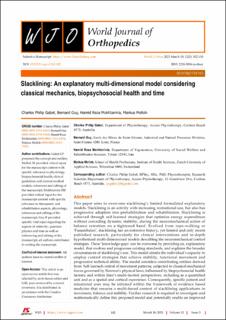Please use this identifier to cite or link to this item:
https://doi.org/10.21256/zhaw-25899Full metadata record
| DC Field | Value | Language |
|---|---|---|
| dc.contributor.author | Gabel, Charles Philip | - |
| dc.contributor.author | Guy, Bernard | - |
| dc.contributor.author | Mokhtarinia, Hamid Reza | - |
| dc.contributor.author | Melloh, Markus | - |
| dc.date.accessioned | 2022-10-28T13:24:41Z | - |
| dc.date.available | 2022-10-28T13:24:41Z | - |
| dc.date.issued | 2021 | - |
| dc.identifier.issn | 2218-5836 | de_CH |
| dc.identifier.uri | https://digitalcollection.zhaw.ch/handle/11475/25899 | - |
| dc.description.abstract | This paper aims to overcome slacklining's limited formulated explanatory models. Slacklining is an activity with increasing recreational use, but also has progressive adoption into prehabilitation and rehabilitation. Slacklining is achieved through self-learned strategies that optimize energy expenditure without conceding dynamic stability, during the neuromechanical action of balance retention on a tightened band. Evolved from rope-walking or 'Funambulus', slacklining has an extensive history, yet limited and only recent published research, particularly for clinical interventions and in-depth hypothesized multi-dimensional models describing the neuromechanical control strategies. These 'knowledge-gaps' can be overcome by providing an, explanatory model, that evolves and progresses existing standards, and explains the broader circumstances of slacklining's use. This model details the individual's capacity to employ control strategies that achieve stability, functional movement and progressive technical ability. The model considers contributing entities derived from: Self-learned control of movement patterns; subjected to classical mechanical forces governed by Newton's physical laws; influenced by biopsychosocial health factors; and within time's multi-faceted perspectives, including as a quantified unit and as a spatial and cortical experience. Consequently, specific patient and situational uses may be initiated within the framework of evidence based medicine that ensures a multi-tiered context of slacklining applications in movement, balance and stability. Further research is required to investigate and mathematically define this proposed model and potentially enable an improved understanding of human functional movement. This will include its application in other diverse constructed and mechanical applications in varied environments, automation levels, robotics, mechatronics and artificial-intelligence factors, including machine learning related to movement phenotypes and applications. | de_CH |
| dc.language.iso | en | de_CH |
| dc.publisher | Beijing Baishideng BioMed Scientific | de_CH |
| dc.relation.ispartof | World Journal of Orthopedics | de_CH |
| dc.rights | https://creativecommons.org/licenses/by-nc/4.0/ | de_CH |
| dc.subject | Biopsychosocial | de_CH |
| dc.subject | Human movement | de_CH |
| dc.subject | Model | de_CH |
| dc.subject | Slacklining | de_CH |
| dc.subject | Time | de_CH |
| dc.subject.ddc | 615: Pharmakologie und Therapeutik | de_CH |
| dc.title | Slacklining : an explanatory multi-dimensional model considering classical mechanics, biopsychosocial health and time | de_CH |
| dc.type | Beitrag in wissenschaftlicher Zeitschrift | de_CH |
| dcterms.type | Text | de_CH |
| zhaw.departement | Gesundheit | de_CH |
| zhaw.organisationalunit | Institut für Public Health (IPH) | de_CH |
| dc.identifier.doi | 10.5312/wjo.v12.i3.102 | de_CH |
| dc.identifier.doi | 10.21256/zhaw-25899 | - |
| dc.identifier.pmid | 33816138 | de_CH |
| zhaw.funding.eu | No | de_CH |
| zhaw.issue | 3 | de_CH |
| zhaw.originated.zhaw | Yes | de_CH |
| zhaw.pages.end | 118 | de_CH |
| zhaw.pages.start | 102 | de_CH |
| zhaw.publication.status | publishedVersion | de_CH |
| zhaw.volume | 12 | de_CH |
| zhaw.publication.review | Peer review (Publikation) | de_CH |
| zhaw.author.additional | No | de_CH |
| zhaw.display.portrait | Yes | de_CH |
| Appears in collections: | Publikationen Gesundheit | |
Files in This Item:
| File | Description | Size | Format | |
|---|---|---|---|---|
| 2021_Gabel-etal_Slacklining-multi-dimensional-model-considering-mechanics-health-time.pdf | 510.12 kB | Adobe PDF |  View/Open |
Show simple item record
Gabel, C. P., Guy, B., Mokhtarinia, H. R., & Melloh, M. (2021). Slacklining : an explanatory multi-dimensional model considering classical mechanics, biopsychosocial health and time. World Journal of Orthopedics, 12(3), 102–118. https://doi.org/10.5312/wjo.v12.i3.102
Gabel, C.P. et al. (2021) ‘Slacklining : an explanatory multi-dimensional model considering classical mechanics, biopsychosocial health and time’, World Journal of Orthopedics, 12(3), pp. 102–118. Available at: https://doi.org/10.5312/wjo.v12.i3.102.
C. P. Gabel, B. Guy, H. R. Mokhtarinia, and M. Melloh, “Slacklining : an explanatory multi-dimensional model considering classical mechanics, biopsychosocial health and time,” World Journal of Orthopedics, vol. 12, no. 3, pp. 102–118, 2021, doi: 10.5312/wjo.v12.i3.102.
GABEL, Charles Philip, Bernard GUY, Hamid Reza MOKHTARINIA und Markus MELLOH, 2021. Slacklining : an explanatory multi-dimensional model considering classical mechanics, biopsychosocial health and time. World Journal of Orthopedics. 2021. Bd. 12, Nr. 3, S. 102–118. DOI 10.5312/wjo.v12.i3.102
Gabel, Charles Philip, Bernard Guy, Hamid Reza Mokhtarinia, and Markus Melloh. 2021. “Slacklining : An Explanatory Multi-Dimensional Model Considering Classical Mechanics, Biopsychosocial Health and Time.” World Journal of Orthopedics 12 (3): 102–18. https://doi.org/10.5312/wjo.v12.i3.102.
Gabel, Charles Philip, et al. “Slacklining : An Explanatory Multi-Dimensional Model Considering Classical Mechanics, Biopsychosocial Health and Time.” World Journal of Orthopedics, vol. 12, no. 3, 2021, pp. 102–18, https://doi.org/10.5312/wjo.v12.i3.102.
Items in DSpace are protected by copyright, with all rights reserved, unless otherwise indicated.